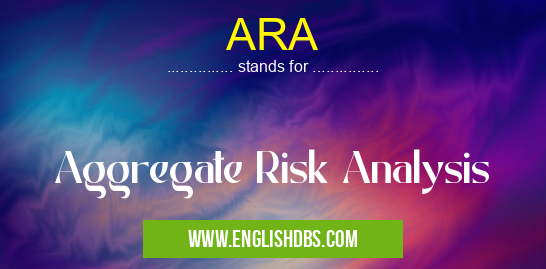What does ARA mean in UNCLASSIFIED
Aggregate Risk Analysis (ARA) is a comprehensive risk assessment technique used in various industries to identify, assess, and manage risks across an organization. It involves analyzing the combined impact of individual risks to determine the overall risk exposure of the organization. ARA provides a holistic view of risks, enabling organizations to prioritize and mitigate them effectively.

ARA meaning in Unclassified in Miscellaneous
ARA mostly used in an acronym Unclassified in Category Miscellaneous that means Aggregate Risk Analysis
Shorthand: ARA,
Full Form: Aggregate Risk Analysis
For more information of "Aggregate Risk Analysis", see the section below.
Types of ARA
There are various types of ARA, including:
- Qualitative ARA: Focuses on identifying and assessing risks based on expert judgment and experience.
- Quantitative ARA: Uses numerical data and statistical techniques to quantify the likelihood and impact of risks.
- Integrated ARA: Combines both qualitative and quantitative methods to provide a comprehensive risk assessment.
Process of ARA
The ARA process typically involves the following steps:
- Risk Identification: Identifying potential risks that may impact the organization's objectives.
- Risk Assessment: Assessing the likelihood and potential impact of each identified risk.
- Risk Prioritization: Ranking risks based on their likelihood, impact, and importance to the organization.
- Risk Mitigation: Developing and implementing strategies to mitigate or eliminate identified risks.
- Risk Monitoring: Continuously monitoring and reviewing risks to ensure effective mitigation and prevent future incidents.
Benefits of ARA
ARA offers several benefits to organizations, including:
- Improved Risk Visibility: Provides a clear understanding of the organization's overall risk exposure.
- Enhanced Decision-Making: Supports strategic decision-making by identifying potential risks and their impact.
- Prioritized Risk Mitigation: Enables organizations to focus resources on mitigating the most critical risks.
- Regulatory Compliance: Helps organizations meet regulatory requirements and standards related to risk management.
Essential Questions and Answers on Aggregate Risk Analysis in "MISCELLANEOUS»UNFILED"
What is Aggregate Risk Analysis (ARA)?
ARA is a comprehensive risk assessment technique that identifies, assesses, and prioritizes the aggregate risks faced by an organization. It involves analyzing the potential impact and likelihood of various risks across multiple business units, departments, and operations. By considering these risks in totality, ARA helps organizations gain a holistic understanding of their overall risk profile.
Why is ARA important?
ARA is crucial for organizations because it:
- Provides a comprehensive view of all potential risks, allowing for informed decision-making.
- Enables organizations to prioritize risks and allocate resources accordingly.
- Identifies emerging risks and vulnerabilities that may not be evident through traditional risk assessments.
- Supports regulatory compliance and risk management policies.
- Facilitates effective communication and coordination of risk management across the organization.
What are the steps involved in conducting an ARA?
The steps involved in conducting an ARA typically include:
- Risk identification: Identifying all potential risks that could impact the organization.
- Risk assessment: Evaluating the likelihood and impact of each identified risk.
- Risk prioritization: Ranking risks based on their severity and potential consequences.
- Mitigation planning: Developing strategies to mitigate or control identified risks.
- Monitoring and review: Regularly reviewing and updating the ARA to ensure it remains current and effective.
What are some common challenges in conducting an ARA?
Common challenges in conducting an ARA include:
- Data availability and accuracy: Gathering reliable data on all potential risks can be challenging.
- Subjectivity in risk assessment: Assessing the likelihood and impact of risks often involves subjective judgments.
- Complexity and scale: ARA can be complex and time-consuming, especially for large organizations with diverse operations.
- Communication and stakeholder involvement: Effectively communicating ARA results and engaging stakeholders is crucial for its success.
Final Words: Aggregate Risk Analysis is a valuable tool for organizations looking to effectively manage risks and protect their reputation, financial stability, and operational efficiency. By conducting thorough ARA, organizations can gain a comprehensive understanding of their risk exposure, prioritize mitigation efforts, and make informed decisions to safeguard their future success.
ARA also stands for: |
|
| All stands for ARA |
